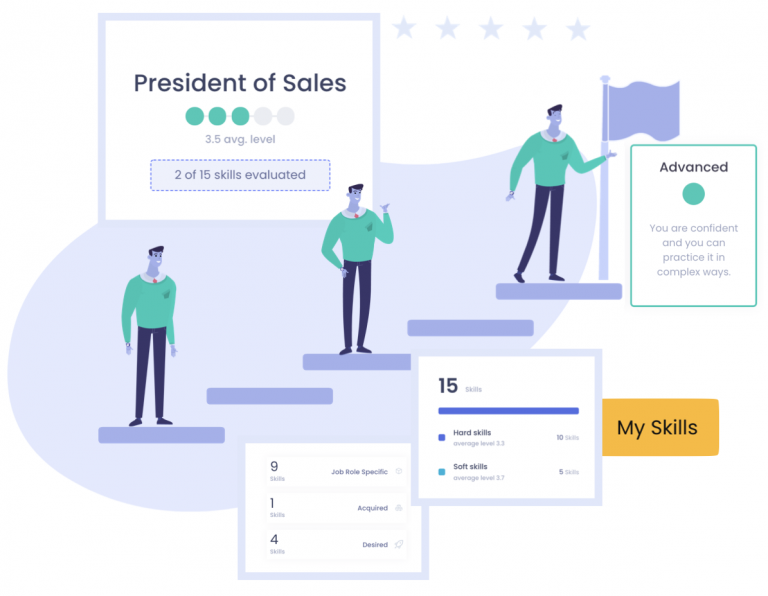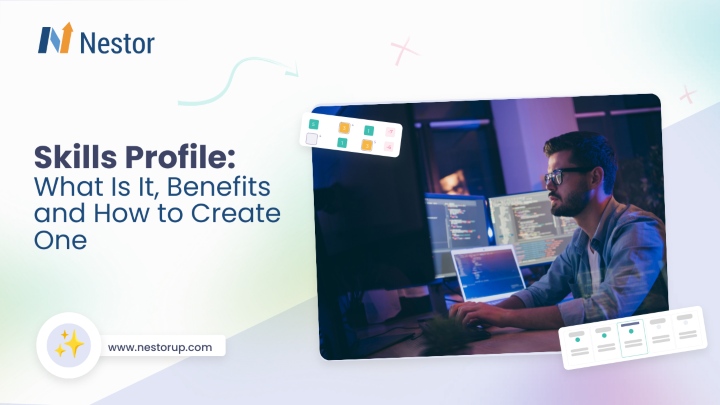
Skills mapping is not just a routine administrative task; it’s a strategic imperative for modern organizations aiming to thrive in dynamic environments. At its heart, skills mapping involves carefully charting out the skills and abilities of employees across different levels and departments required for their job roles. This process isn’t merely about creating a static list of skills; it’s about delving into the intricacies of each individual’s strengths and weaknesses.
You can apply it to the organization as a whole, but also for departments, at the individual level, or to specific projects. With skills constantly shifting and people working on multiple projects, modern skills mapping involves everyone from managers to HR teams to individual workers.
Knowing what skills are needed for particular roles, tasks, or projects is key to effective skills mapping. By meticulously analyzing the skill sets required for different functions, organizations can make informed decisions regarding talent acquisition, task allocation, and project staffing.
This proactive approach empowers managers to spot skill gaps early on, mitigating potential risks that could impede business operations in the short or long term. It also supports organizations in efficiently using existing skills by redeploying talent fast, planning for future recruitment, or guiding the learning and development programs.
As Josh Bersin, a leading voice in HR and organizational development, pointed out in his article, “Once you get started you will see that skills play a role in hiring, mobility, development, diversity, and even pay”. Skills not only influence recruitment and mobility decisions but also inform diversity initiatives and compensation structures. Embracing a skill-centric approach transcends mere operational efficiency; it fosters a culture of continuous learning and adaptability, essential traits for staying competitive in today’s volatile marketplace.
The benefits of focusing on skills aren’t just theoretical. McKinsey & Company’s research shows that when organizations adjust their HR processes to fit their skill needs, they see big improvements. Employee engagement goes up by 50%, while training costs drop by the same amount. Plus, productivity gets a significant 40% boost. This highlights how important skills mapping is for making organizations stronger and more adaptable.
Identify required skills
To easily identify areas with skills that are in high demand or short supply you must take a close look inside your organization. You can start by analyzing the current company strategy and the plans for the coming years.
Pinpoint the essential skills and capabilities your company needs most to successfully run new strategic projects, achieve business transformation, or expand into new markets. This will help you figure out the key skills needed to tackle new projects, drive transformation, or enter new markets. By doing this, you can see where your team’s strengths lie and what skills you might need to bring in from outside.
AI can play a significant role in this regard. It can leverage extensive datasets and advanced algorithms to analyze elements such as market trends and the trajectory of your industry. With AI tools, organizations can get really useful insights into the skills and abilities they need to handle the complexities of modern business.
For instance, imagine a multinational corporation seeking to embark on a strategic initiative to leverage blockchain technology for supply chain optimization. Through AI-powered data analysis, the organization can discern the specific technical competencies required for implementing and managing blockchain solutions effectively. Furthermore, AI algorithms can identify potential skill gaps within the existing workforce, thereby informing targeted training programs or external recruitment strategies.
In this new digitally disrupted work, both digital and soft skills must be a particular concern. Access to specific digital expertise but also the necessary soft skills that ensure smoother collaboration between teams and agility in the workplace is equally important. Another thing to consider is looking at your competition and how your industry is expected to change under the influence of technology.
Moreover, AI contributes to the identification of both digital and soft skills essential for organizational success. While technical proficiencies in areas such as data analytics, artificial intelligence, and cybersecurity are crucial, the significance of soft skills, including communication, leadership, and adaptability, cannot be overstated. AI-driven assessments can evaluate not only the proficiency levels of digital skills but also the interpersonal abilities necessary for fostering collaboration and driving innovation within teams.
Armed with this understanding of skill requirements, organizations can better position themselves to navigate the complexities of the modern business landscape. This proactive approach not only allows businesses to strategically align their talent acquisition, development, and deployment efforts but also enables them to capitalize on emerging opportunities and mitigate potential risks.
Set proficiency levels
As important as it may be to run this first step, without setting up different proficiency levels associated with particular skills and roles, you can’t have a complete evaluation. Within any company or department, the employees have different levels of expertise that will vary over time.
With an application like Nestor, you can set up the required proficiency level and compare it versus the actual proficiency level. Each employee profile will display this information together with activities required for the job role, development plan, or even certifications. Moreover, managers can suggest skill proficiency levels for their direct reports.
Let’s consider a software development company that adopts Nestor to manage talent. Within the system, administrators set proficiency benchmarks for programming languages, such as Python, Java, and C++. These benchmarks are tailored to different roles, such as software engineer, data scientist, or quality assurance analyst.
Managers can view each employee’s profile, which showcases the delta between required proficiency and actual proficiency for each skill. Additionally, Nestor suggests personalized development plans and certification pathways based on these insights.
This comprehensive approach enables the swift identification of employees with deep expertise and high skill levels. For instance, when a critical project requiring advanced Python knowledge emerges, managers can readily pinpoint team members who meet the proficiency criteria and assign them to the task.
Beyond facilitating project assignments, this approach fosters a culture of continuous learning and development. Employees receive targeted guidance on areas where they need improvement, enhancing their overall competency and adaptability.
In essence, by leveraging talent management tools like Nestor and embracing a holistic perspective on proficiency levels, organizations empower their workforce to thrive in a rapidly evolving landscape. This not only ensures efficient task allocation but also cultivates a dynamic environment conducive to innovation and growth.

Assess the current skills
To plan for the future, first, you need to have a clear picture of the current skills in your organization. Tools like Nestor can help you evaluate current skill levels from multiple points of view. So you can have the manager’s perspective from a skills assessment, a performance review, or 360-degree feedback and even skills endorsements from peers.
Employees will also be able to self-evaluate their skills using different proficiency levels. In our opinion, allowing employees to self-assess their skills it’s a big win. When you encourage employees to express their opinions, you show them trust and involve them in finding solutions and getting things done.
While self-assessment is valuable, it can sometimes overlook gaps or inadequacies or include biases. For a more accurate overview, Nestor addresses this limitation by incorporating input from various sources, including performance reviews and 360-degree feedback. For instance, while an employee may highlight certain skills on their profile, a performance review might reveal additional strengths or areas needing improvement. Similarly, 360-degree feedback provides a holistic perspective by gathering insights from supervisors, peers, and direct reports, offering a more nuanced understanding of an individual’s capabilities.
By leveraging these diverse sources of information, organizations can paint a more accurate and nuanced picture of their employees’ skills. This not only facilitates targeted skill development initiatives but also enables more informed decision-making regarding succession planning or possible talent deployment initiatives.
While conducting skills mapping provides a foundational understanding of organizational skill distribution, it is essential to align this process with the individual career aspirations, interests, and capabilities of employees. By harmonizing skills assessments with personal goals, organizations can cultivate a workforce that is not only skilled but also motivated and fulfilled in their roles. This alignment not only enhances employee satisfaction and retention but also facilitates organizational agility and adaptability in the face of evolving challenges and opportunities.
Identify gaps and act on them
Learning without action is like having a recipe but never cooking the meal. It’s the final step—spotting the gaps in skills and then doing something about them—that really makes a difference. With a clear picture of both actual and desired proficiency levels, companies can address existing competency gaps so that managers can create and assign development goals for employees, and initiate learning and mentorship programs or additional training.
Addressing skill gaps isn’t just about being efficient; it’s also about being resilient. In today’s fast-paced world, industries evolve rapidly. Skills that were valuable yesterday might be obsolete tomorrow. By patching up skill gaps now, companies prepare themselves for whatever the future holds.
Now, let’s talk tools. Platforms like Nestor play a pivotal role in this process. Nestor facilitates the identification of skill gaps and offers ongoing progress monitoring, enabling informed decision-making and intervention refinement. Its data-driven insights allow for a nuanced analysis of individual, team, and departmental skill deficiencies, guiding resource allocation and strategic initiatives.
Nestor’s interface offers an easy visualization of skill gaps, whether it’s for one person, a whole team, or even at the organizational level with the help of skills matrices. They point out skills distribution across team members, providing managers with valuable insights on who needs specific training, to bridge the skills gaps or pin point employees with high level of expertise for specific skills that are extremely valuable for the organization.

Final thoughts
Conducting a skills mapping is beneficial both to your company and your people in several ways:
- Addresses the existing skills gaps: By conducting a thorough skills mapping exercise, companies can proactively identify existing skills gaps within their workforce. This proactive approach prevents these gaps from evolving into critical issues that could impede productivity or hinder progress.
- Bridges skills gaps with personalized opportunities for development: Maximize the effectiveness of the learning programs with personalized opportunities for learning and development based on specific skills gaps. Ensure alignment of individual skills with organizational goals → https://nestorup.com/skills-driven-performance-management/
- Adaptation to Digital Transformation: In today’s rapidly evolving digital landscape, staying abreast of technological advancements is imperative for businesses to remain competitive. Skills mapping facilitates this adaptation process by ensuring that employees possess the necessary competencies to navigate and leverage digital tools and platforms effectively.
- Fostering a Culture of Growth: Effective skills mapping nurtures a culture of continuous learning and growth within the organization. By providing every employee with opportunities for skill development and career advancement, companies cultivate an environment where individuals feel valued and motivated to pursue their professional aspirations.
- Optimized Utilization of Talent: By identifying and leveraging employees’ strengths and interests, skills mapping enables organizations to optimize the utilization of talent. When individuals are empowered to focus on tasks aligned with their core competencies and passions, productivity and job satisfaction are enhanced, ultimately benefiting both the employee and the company as a whole.










